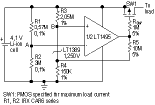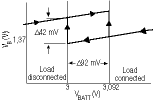Application cameo - 4,5 µA protection circuit lengthens Li-ion battery life
22 November 2000
Circuit & System Protection
If a Li-ion battery discharges below the recommended end-of-discharge voltage, the cycle life shortens and the battery dies prematurely.
Linear Technology describes the circuit in Figure 1 that monitors a Li-ion battery and disconnects the load to protect the battery from deep discharge when the battery voltage drops below a preset lockout voltage, while itself consuming only 4,5 µA.
Figure 1. This ultra-low power, undervoltage lockout circuit disconnects the load to prevent deep discharge and permanent loss of battery capacity
For example, a lockout voltage of 3 V, set by the ratio of R1 and R2, is sensed at node A. When the battery voltage falls below the lockout voltage, node A falls below the threshold at node B, which is equal to:
VB = 1,25 V + I • R4 = 1,37 V
where:
I = (VT - 1,25 V)/(R3 + R4) = 800 nA,
and VT = lockout voltage.
The output of the LT1495 will then swing high, turning off SW1 and disconnecting the load from the battery. To avoid oscillation due to the battery recovering when the load is disconnected, R5 is added to provide hysteresis around the trip point (Figure 2). With the resistor values shown, the hysteresis for the circuit is 92 mV. VBATT must climb back above 3,092 V before the load is reconnected.
Figure 2. R5 is added toprovide hysteresis around the trip point to avoid oscillation
Hysteresis = VB' • R1/R2 + VB' - VT where:
VB' = (VOMAX - I • R4) • R4/R5 + VREF + I • R4
and:
VOMAX = maximum output swing (high) of op-amp when VBATT is equal to the lockout voltage.
The desired amount of hysteresis may be determined by multiplying the maximum ESR recommended for the battery by the recommended discharge current.
A lockout of too high a voltage will decrease the maximum capacity of a battery and reduce its operating range. With too low a lockout voltage, the battery is discharged too deeply, reducing its performance and life. With the 0,4% overall accuracy of the circuit shown, the lockout voltage has a narrow range of 2,988 to 3,012 V.
For further information on Linear Technology products, contact Insight, (021) 674 4103.
Further reading:
Clearing the Static: Staying grounded
Actum
Circuit & System Protection
To maintain reliable electrostatic discharge control, regular testing and accurate measurement are essential, with grounding products and ESD testing equipment being vital.
Read more...
Smarter protection without disruption
NewElec Pretoria
Circuit & System Protection
Designed for operations still running without integrated automation, NewElec’s retrofit-friendly systems let you upgrade performance and safety without overhauling your entire network.
Read more...
Circuit breaker for reliable, compliant protection
RS South Africa
Circuit & System Protection
Legrand’s low-voltage power distribution portfolio encompasses the DX3 range of miniature circuit breakers, designed to deliver dependable protection in residential, commercial and industrial installations.
Read more...
Reducing noise on power supply lines
Future Electronics
Circuit & System Protection
Murata has introduced the EMIFIL ESD Series Noise Filters, a breakthrough solution engineered for superior noise suppression and enhanced electrostatic discharge (ESD) protection.
Read more...
Clearing the Static: Fundamental principles of static control
Actum
Circuit & System Protection
Controlling electrostatic discharge in electronics manufacturing is essential with effective ESD programs built on six key principles.
Read more...
Electrical fire safety in lithium-ion battery rooms
Circuit & System Protection
Pratliperl is a non-combustible, ultra-lightweight aggregate that can be mixed with cement and applied as a plaster or screed to walls, floors, and ceilings.
Read more...
Clearing the Static: ESD training in the workplace
Actum
Circuit & System Protection
To protect sensitive electronic components, A structured, consistent, and sustainable ESD training program is essential.
Read more...
Protect your pumps – protect your profit
NewElec Pretoria
Circuit & System Protection
In South Africa’s demanding agricultural landscape, irrigation is not just an essential service – it is the heartbeat of farm productivity.
Read more...
Clearing the Static: ESD and installation: A durable antistatic solution
Actum
Circuit & System Protection
ESD flooring provides a reliable, long-term solution for managing static electricity by safely dissipating static charges through the floor to a designated ground point.
Read more...
Why wait to automate
NewElec Pretoria
Circuit & System Protection
NewElec’s initiative helps you gain operational visibility via HMI or PLC by retrofitting intelligent motor protection relays without replacing MCCs or rewiring the plant.
Read more...



